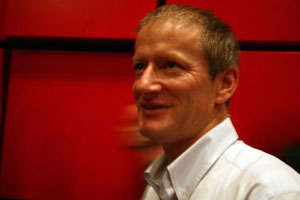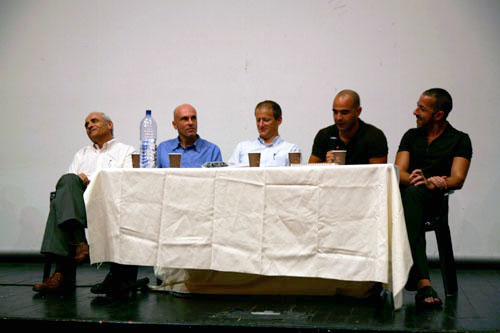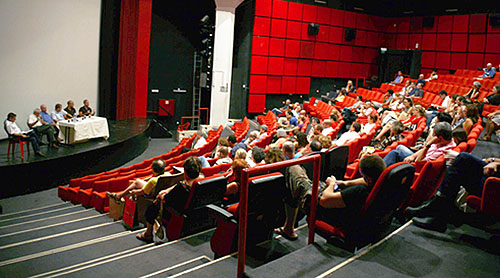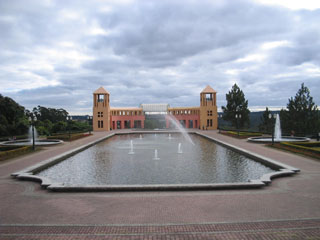Sometimes it is necessary to confront our decision-makers with what has been called “the threat of a good example” – to bring them face to face with evidence that, despite their insistence to the contrary, it is possible to do things differently.
That, in a nutshell, was the idea behind an event held last week at the Tel Aviv Cinemateque which challenged Israel’s city planners to think creatively about Israel’s cities and the many challenges they face.
The event began with the screening of “Urban Legend,”a 50 minute Hebrew film which recounts the courageous steps that various cities around the world have taken to improve the quality of life of their residents, while lessening the pressure they put on their environments.
The film was followed by a panel discussion, which included the participation of the official city planners of Haifa, Netanya and Tel Aviv. Moderator Nitzan Horowitz, who directed the film, posed them the following question:
“If they can do it there, why can’t we do it here?”
The City is the Solution
Produced by Channel 10 reporter and graduate of the Heshel Center’s Environmental Fellows Program Nitzan Horowitz, the film follows Horowitz as he visits an artificial trash island turned urban park in Japan, wows over super-sophisticated 3D models of future ecocities in China and interviews elderly street car passengers in Portland in his search for the elements that create a good city.
The star of the film, however, is Jaime Lerner, the former mayor of Curitiba – a city whose name has become synonymous with good, sustainable urban design. Lerner, appointed mayor of Curitiba in the 1970’s (ironically, by Brazil’s then-ruling military junta), managed to completely transform his city by using simple, creative solutions to complex problems. “The city is not the problem, the city is the solution,” he likes to say.
While the list of Lerner’s achievements is too long to relate here in full, suffice to say that Curitiba, formerly a nondescript place with the usual list of environmental pressures and problems, is today a city with a 70% recycling rate, a network of expansive urban parks, zero traffic jams and an over 90% satisfaction rate among its citizens.
One of Lerner’s most impressive achievements in Curitiba is the invention of a new form of mass transit, which later came to be referred to as Bus Rapid Transit (BRT). Faced with growing traffic problems, Mayor Lerner was presented with the choice between building an expensive subway system or a destructive highway system in his city. Not satisfied with either option, Lerner created a system of extended buses that functions like a subway, with exclusive lanes, frequent and comfortable service and high carrying capacity – for 1% of the cost of a subway!

A rendering of a BRT station in Guangzhou, China. Curitiba's transit system has inspired numerous projects like these around the world. (Source: ITDP.org)
Curitiba Comes to Tel Aviv
Anyone who has ever walked, jogged, driven, biked, rollerbladed or seqwayed down the streets of Tel Aviv knows that the biggest obstacle to providing Tel Avivians with a higher quality of life is the traffic jams and the lack of a good mass transit alternative. So after traveling to Curitiba and exploring the wonders of sustainable urban design and transportation there, Horowitz invites Jaime Lerner to Tel Aviv, where Lerner (a Jew with relatives in Israel) discusses how his planning philosophy, which he calls “urban acupuncture,” could be put into action in Tel Aviv. Here’s an except:
[youtube]http://www.youtube.com/watch?v=bN6EC5bV6ms[/youtube]
Jaime Lerner has this to say about Tel Aviv:
I think this city could be jewel. It is not difficult. Because it has everything, good waterfront, good street life – the only thing is the cars… when you give more importance to the car than people, it happens. They give the car the red carpet and we have to climb or go underground. But this could be fixed very easily.
Sometimes you are waiting for the subway 50 years, when you can have right now, in less than two years, a better system that is on surface. People say “no we cannot have dedicated lanes for buses, because we need them for cars. This is an egoist’s reasoning.”
To which Horowitz replies, “But this is exactly what they told me in city hall, that they need the space for the cars.”
In another scene, Lerner, while riding one of his city’s iconic buses, turns to the camera and says, “Please mayors from Israel, make dedicated lanes for public transport, please, bivakesha.”
Don’t Look at Me
The film, and especially the scenes of Lerner in Tel Aviv, made a strong impression on the audience, and, as the lights came on and the members of the panel took their seats, the sense of expectation was almost palpable. However, as one man from the audience put it: “It was like, after seeing this fantastic vision of what could be, suddenly they brought us all back down to reality, where everything is stuck.”
As Horowitz opened up the discussion, all eyes were on Hezi Berkowitz, the Tel Aviv’s municipality’s official city planner. Berkowitz, not an exciting speaker even at his best, proceeded to advocated for the status quo.

Tel Aviv City Engineer Hezi Berkowitz: "Reorganization of the bus system is not under my responsibility." (Daniel Cherrin)
Berkowitz opened by stating that things in metropolitan Tel Aviv are improving. The proof of this, he noted, is that people want to move to the cities in the center of the country.
Regarding the lack of a viable system of mass transit in the metropolis, Berkowitz stated, “I don’t think it is appropriate here to assign blame,” and then hinted that the fault lies with the Ministry of Transportation and the Treasury.
He went on to point out that a transport system based on exclusive bus lanes cannot transport more than 4,000 passengers per hour in a given direction. In Haifa, he noted, the Metronit (the city’s new BRT line, opening in 2010) is planned to carry 2,000 passengers per hour per direction. During Tel Aviv’s morning rush hour, however, the situation calls for moving around 9,000 people per hour – thus moving these people by buses is impossible.
Berkowitz did not say where he found these figures, but studies have shown that a system such as Curitiba’s, based on extended buses, can carry up to 24,000 passengers at peak hours.
This was not the first time that Berkowitz was confronted with the Curitiba model. In fact, the southern Brazilian town’s name comes up quite often in his public appearances, and is usually brought up by residents and activists as an example of what Tel Aviv could be doing. In a neighborhood event in June hosted by the SPNI, entitled “Northern Exposure,” Berkowitz proclaimed: “What people don’t realize about Curitiba is that their mass transit system is based on buses. Just buses, not light rail, not subway… Give me 20 minutes and I’ll rip the Curitiba model to pieces.”
Berkowitz later fielded an avalanche of questions and comments, not all of them friendly, from Tel Aviv residents in the audience, promoting another member of the panel to remark, “This is a rare case where being the home team is not an advantage.”
Members of the audience quizzed Berkowitz about several prominent municipal issues, including:

Nitzan Horowitz fields questions from the audience after screening his movie "Urban Legend" at the Tel Aviv Cinemateque. (Daniel Cherrin)
Ayalon East, a new highway, planned to run through the eastern part of the Yarkon Park. Berkowitz responded that, according to surveys and simulations, the number of cars on the road is constantly rising, leading to more cars on the same amount of roads, thus leading to congestion and the need to build more roads.”Widen a river, and the same amount of water flows though it. When we open a new highway, we relieve the pressure on exisiting roads.” He did note, however, that conservation of the park was also an important consideration. To this Nitzan Horowitz replied that every year another 60,000 cars are added to the roads in metropolitan Tel Aviv, and that, in the absence of a mass transit alternative, the roads will just become congested again in another few years, no matter how many new roads are built.
The continuing renovation of Ibn Gvirol Street. One member of the audience pointed out that the new bike lanes on the street were built at the expense of decades-old trees, which were uprooted by the city in one of the most polluted stretches of Tel Aviv. Every month or so, he noted, the city advances north, cutting down another few blocks of trees. Worse still, the bike lanes that were built are barely even usable, as they were built on the sidewalk with all kinds of obstacles standing in the way of bikers. Berkowitz responded that Tel Aviv today has almost 100 km of bike lanes (a figure which drew laughter and catcalls from the crowd), and that according to the Ministry of Transportation it is OK to build bike lanes on the sidewalk.
In Haifa, Things are Looking Up

The panel(from left): Netanya City Engineer Paul Vital, Haifa City Engineer Ariel Veterman, Tel Aviv City Engineer Hezi Berkowitz, Arik Tapiero of SPNI, Dr. Yishai Blank of Tel Aviv University. (Daniel Cherrin)
A slightly more optimistic picture was painted by Haifa city engineer Ariel Veterman. The Metronit, Haifa’s own BRT system which is slated to begin operating in his city in 2010, will have a headway of 5 minutes and is expected to bring about a revolution in the city center, which he said will be unrecognizable in a few years. “Maybe in ten years we can make a movie about urban renewal in Haifa,” he offered, only half in jest.
Arik Tapiero of the Society for the Protection of Nature in Israel observed that, while public transportation plans exist on paper, in reality Tel Aviv is building roads and promoting policies that favor the private car over public transport. He called for the creation of a metropolitan transport authority saying, “The pubic needs to organize and fight for good public transportation in Tel Aviv. This is the only way that it will happen.” The defeat of the Safdie Plan for Jerusalem’s westward expansion, noted Tapiero, was only made possible by broad public mobilization.
A different perspective was provided by Dr. Yishai Blank, of Tel Aviv University’s Faculty of Law, who argued that public transport alone will not save the city, especially if the city neglects to build affordable housing and mixed use streets. He noted that, due to less central government involvement in funding local governments, cities are now forced to get most of their funds from developers, which weakens cities’ ability to impose design guidelines on them. The result is that new construction in the cities mimics suburban forms instead providing quality urbanism.
Conspicuously absent from the discussion was the voice of A City for All, Tel Aviv’s new political actor, whose representatives have declared that, if elected, Curitiba’s programs would serve them as a model for developing Tel Aviv. Last week, A City for All’s candidate for mayor, Dov Khenin, discussed his plans for reforming the city’s transport system on an online forum hosted by The Marker (Hebrew link). He proposed a network of BRT lines with free transfers between them as an interim transportation solution, until the subway and light rails finally materialize.
So what does the future hold for the residents of metropolitan Tel Aviv? Will quality of life in the “Big Orange” ever rival that of Portland or Curitiba? Horowitz sums it up well in the closing scene of “Urban Legend”:
The solution to the city’s problems is not found in massive budgets, nor in complicated plans. The solution is found in the basic understanding that the city is a space for social progress. And when someone who understands this takes charge of the city – the change is very rapid.
Nitzan Horowitz’s film “Urban Legend” is part of a series entitled Haolam Haba, which features several fascinating short films on topics related to changes in the world’s economy, environment and society that will make the current century different from the last one. All of the episodes can be viewed for free on the internet on Channel 10’s website (apparently more compatible with Internet Explorer than with Firefox). Highly recommended!






All very interesting, and I wish you well in your quest to reduce car dominance and save the trees! In the video I loved (!) the shot of the elderly couple struggling against the tide in the alien concrete jungle! What a travesty of human civilisation! It is definitely high time to reclaim our urban realm from the technocrats, who have been ruling and ruining our lives for too long. There could be a danger of overreacting against dominion of the vehicle, and until there is a viable alternative to personal transport that is equally convenient in all circumstances, it could be construed as an attack on individual freedom. But you seem to be pursuing positive compromise, which is good, rather than negative coercion – symbolised by London’s premature congestion charge – which is bad. My campaign, FiT Roads, which seeks to make Roads FiT for People, aims to free all road-users to use commonsense and common courtesy on roads free of counterproductive traffic controls. (I too have family in Israel by the way – how are you, Ran & co?)